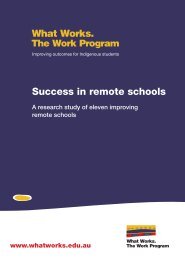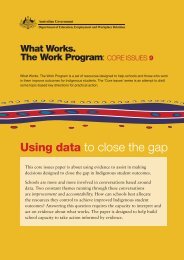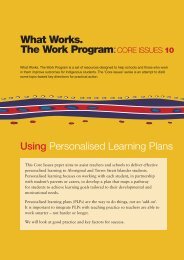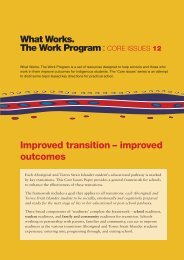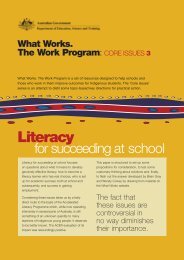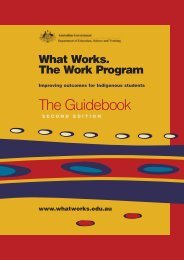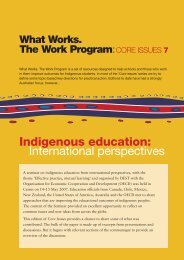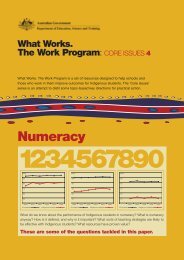SCIENCEWorking Scientifically(Note that this str<strong>and</strong> should be addressed simultaneously with all Science content str<strong>and</strong>s)Concept In Year 1the student:In Year 2the student:In Year 3the student:In Year 4the student:In Year 5the student:In Year 6the student:In Year 7the student:In Year 8the student:In Year 9the student:what they already know,can help them underst<strong>and</strong>or interpret theirobservations eg knowingthat ice melts in a warmplace assists anunderst<strong>and</strong>ing of why ac<strong>and</strong>le might melt in thesun).that dual flush toiletsystems were developed toenable us to save water,<strong>and</strong> that microwave ovensare a relatively recentinvention to make cookingmuch easier than it used tobe, <strong>and</strong> email makes day today communicationsimple).Decision makingincluding ethicalconsideration of theimpact of processes<strong>and</strong> products ofscience on people <strong>and</strong>the environment• Knows that being safe isimportant when they areusing their senses (e.g.they know they shouldn’ttaste or touch some things<strong>and</strong> that looking at the sunis unsafe; they know whythey should wash theirh<strong>and</strong>s after h<strong>and</strong>ling livingthings). HPE• Knows the importance ofbeing responsible (ietakes care of <strong>and</strong> respecteach other, any equipmentthey use <strong>and</strong> the living <strong>and</strong>non-living environmentwhen makingobservations).• Knows the need to actresponsibly when takingmeasurements <strong>and</strong>working in groups (e.g.care is needed whenmeasuring water so theydon’t make a mess or wetothers, while equipmentneeds to be looked after toavoid breakages). T• Knows why safety isimportant when doinginvestigations.• Explains why they need toact responsibly towardseach other, the equipment<strong>and</strong> towards any livingthings they may beworking with.• Demonstrate their sharedresponsibility <strong>for</strong> theclassroom, school <strong>and</strong>community environment<strong>and</strong> in conservingresources.• Demonstratesunderst<strong>and</strong>ing about whywe need to look after ourenvironment.• Knows that science <strong>and</strong>ethics are closely related(e.g. says “electricity isgood <strong>and</strong> we can’t livewithout it but it can causefires <strong>and</strong> can be dangerousif it’s not used properly”<strong>and</strong> “matches are useful tous but it isn’t right to playwith them or use them tostart bushfires”).• Knows the importance ofscience <strong>and</strong> scientists tosociety in the developmentof things that make ourlives easier (e.g.refrigerators keep foodfresh <strong>and</strong> cars help us toget around) but recognizesthat there is a need todevelop ways of lookingafter the environmentbetter (e.g. car wastes arenot good <strong>for</strong> theenvironment).• Describes appropriateethical issues relevant tothem <strong>and</strong> the consequencesof human activity.• Investigates how theiractions contribute tosustainability of resources<strong>and</strong> the local environment;determines theirenvironmental footprint.• Knows that human activitycan impact in a negativeway on the environment(e.g. use of naturalresources) <strong>and</strong> that theyhave a part to play insociety’s response to thisat the local <strong>and</strong>community level (e.g.knows that l<strong>and</strong> clearing<strong>for</strong> housing is necessarybut impacts on theenvironment <strong>and</strong> thatplanting trees is one wayof ensuring theenvironment issustainable).• Lists <strong>and</strong> demonstratesways of recycling in thehome, school <strong>and</strong>community <strong>and</strong> showssocial responsibility byturning off leaking taps orpicking up litter whereverthey may be.• Demonstrates awareness ofthe negative effects ofman’s activities on thelocal environment (e.g.recognizes that l<strong>and</strong>clearing <strong>and</strong> tourismdevelopment have affectedthe environment, bothliving <strong>and</strong> non-living).• Uses their scientificunderst<strong>and</strong>ings to consider<strong>and</strong> respond to appropriateethical <strong>and</strong> social issuessuch as those related tohealth <strong>and</strong> wellbeing (e.g.underst<strong>and</strong>s that smokingcan lead to cancer <strong>and</strong>recognizes theconsequences of passivesmoking <strong>and</strong> the ethical<strong>and</strong> social issuesassociated with this). HPE• Examines <strong>and</strong> describesissues of the sustainabilityof the natural, built orsocial environment,extending from local toglobal perspective (e.g.underst<strong>and</strong>s that pollutionis a local <strong>and</strong> globalproblem with numerouscauses (includingindustrial, commercial <strong>and</strong>communal) <strong>and</strong> thatalthough scientists areinvolved in findingsolutions, studentsthemselves can play a partin the prevention ofpollution by preventinglitter, actively beinginvolved in clean-ups <strong>and</strong>convincing others to rideor walk instead ofdriving). SS HPE• Makes connectionsbetween local <strong>and</strong> globalenvironmental <strong>and</strong>resource issues.• Investigates <strong>and</strong> describescurrent <strong>and</strong> possible futureimpacts of theircommunities on thesustainability of theenvironment.• Recognises why they needto know <strong>and</strong> underst<strong>and</strong>about important scienceissues <strong>and</strong> in<strong>for</strong>mation inorder to make choicesabout how they live.• Underst<strong>and</strong>s thatenvironmental <strong>and</strong>resource issues affectindividuals, localcommunities <strong>and</strong> the entireplanet <strong>and</strong> recognises theneed <strong>for</strong> cooperation at alllevels to deal with thechallenges.• Suggests ways they can beinvolved in addressingissues at the communitylevel.• Examines <strong>and</strong> describesalternative communitystrategies to minimizepossible future impacts onthe sustainability of theenvironment.• Applies relevant scientificunderst<strong>and</strong>ings to makeresponsible, ethical <strong>and</strong>in<strong>for</strong>med decisions aboutissues including theapplications <strong>and</strong>implications of science <strong>and</strong>sustainability.• Underst<strong>and</strong>s theirresponsibility as acommunity member toshare communal <strong>and</strong>global concerns about theenvironment.• Cites instances in whichsocial priorities have hadan impact on or have beeninfluenced by science ( egscientists know there is alink between increasedincidence of Type 11diabetes <strong>and</strong> obesity in thepopulation there<strong>for</strong>etackling obesity is acurrent social priority, <strong>and</strong>AIDS education programsare the result of scientificresearch revealing howAIDS is spread).• Knows how importantscience is to their dailylives <strong>and</strong> that scienceunderst<strong>and</strong>ings are needed<strong>for</strong> them to be able tomake responsible decisionsabout personal <strong>and</strong>community issues.ScientificInvestigationInvestigation toanswer questionsabout the natural <strong>and</strong>technological worldusing:• Contributes to a classdiscussion aimed atfinding a solution to aproblem suggested by theteacher <strong>and</strong> suggests ideas<strong>for</strong> how they might findsomething out.• Tackles a problemsuggested by the teacher,(e.g. something the groupmight like to find out orknow).• Responds to questionsposed by the teacherrelating to what theyalready know about theproblem in focus.• Contributes relevant ideas,based on their ownpersonal experiences, to aclass discussion aimed atplanning an investigationto solve a problem ofinterest.• When prompted, draws adiagram of what theinvestigation might looklike <strong>and</strong> the equipmentthey could use.• Contributes to a class orgroup plan <strong>for</strong> aninvestigation aimed atsolving a problem.• Develops a simple plan ontheir own (ie suggests howthey might go aboutanswering a question <strong>and</strong>draws a diagram to showwhat they would do).• Derives questions <strong>and</strong>predictions (from theirinterests or experience) <strong>for</strong>testing.• Contributes to planning avariety of investigations,recognizing wherecomparisons might be fairor unfair.• Derives questions <strong>and</strong>predictions <strong>for</strong> testingfrom a given problem orfrom their own interest orexperience.• Plans an investigation witha framework or structureprovided by the teacher,indicating equipment touse <strong>and</strong> scaffolding withrespect to controlled <strong>and</strong>manipulated variables.• Poses questions <strong>and</strong> makespredictions that can beinvestigated scientifically.• Explains their predictionbased on prior knowledge,in simple terms but withno logical explanation.• Plans <strong>and</strong> conductsinvestigationsdemonstrating that theyunderst<strong>and</strong> therequirements of fairtesting (i.e. given the• Underst<strong>and</strong> what ahypothesis is <strong>and</strong> writestheir own hypothesis <strong>for</strong>testing given a problem orquestion by the teacher.Identifies when prompted,the variable to be changed(independent) <strong>and</strong> thevariable to be measured(dependent) <strong>and</strong> uses thisin<strong>for</strong>mation to plan aninvestigation, identifyingthe variables to be• Formulates questions orhypotheses (given acontext by the teacher) <strong>and</strong>plans their owninvestigations, taking intoaccount the principles offair testing.• Identifies withoutprompting, the dependent<strong>and</strong> independent variablesthat need to be controlled.N<strong>Bound</strong> <strong>for</strong> <strong>Success</strong> <strong>Scope</strong> <strong>and</strong> <strong>Sequence</strong> <strong>Statements</strong> V2 Page 47 Working Document Semester One 2007
SCIENCEWorking Scientifically(Note that this str<strong>and</strong> should be addressed simultaneously with all Science content str<strong>and</strong>s)Concept In Year 1the student:In Year 2the student:In Year 3the student:In Year 4the student:In Year 5the student:In Year 6the student:In Year 7the student:In Year 8the student:In Year 9the student:dependent <strong>and</strong>independent variablesthey devise a method tocollect the data requiredto answer the question ortest the prediction).controlled. N- reflection <strong>and</strong>analysis to prepare aplan• Plans <strong>and</strong> conducts simpleinvestigations <strong>and</strong> learnshow to use appropriatetools <strong>and</strong> equipment..• Predicts what they thinkwill happen in theinvestigation <strong>and</strong> why theythink it will happen.• Contributes ideas aboutfactors that may have anaffect on the investigation.• Follows suggestions tocollect, record <strong>and</strong> presentdata.• Makes a prediction aboutwhat might happen <strong>and</strong>knows their investigationis aimed at showingwhether or not theirprediction comes true.• Contributes ideas aboutfactors or variables thatmay have an effect on theinvestigation <strong>and</strong> begins tounderst<strong>and</strong> how thesemight make the results‘unfair’ if they are not thesame each time.• Suggests the type ofvariables that need to beconsidered when doing aninvestigation (e.g. ifplanting seeds to test theeffect of salt water, says“the type of seeds oramount of salt in the waterare important”).• Shows an underst<strong>and</strong>ing offair testing (i.e. the need<strong>for</strong> conditions to be thesame so that the test is‘fair’) (e.g. says ‘I think weshould give all plants thesame amount of water’ or ‘if our group is blowingbubbles in the wind theywon’t last as long as thatgroup’s bubbles will on thever<strong>and</strong>ah so it’s not fair’).• Knows the need <strong>for</strong>controlled variables tomake a fair comparison<strong>and</strong> can suggest severalvariables that need to becontrolled.• Plans how they will collectdata <strong>and</strong> chooses theequipment to be used froma selection suggested orsupplied by the teacher. N• Knows the need to conductpreliminary trials to refineprocedures.• Plans the method of datacollection, independentlychoosing equipment. N- collecting,processing <strong>and</strong>interpreting data• Collects <strong>and</strong> uses simpleequipment (e.g. h<strong>and</strong> lens,cup filled with water,spoon).• Conducts simpleinvestigations with only afew steps, following theteacher’s instructions.• Makes simplemeasurements as part oftheir observations (e.g.measures a cup or half cupof water be<strong>for</strong>e they watera plant, <strong>and</strong> uses a ruler tomeasure how high a plantis in centimeters). N• Uses simple instruments tomake measurements (e.g.graduated jug, cup,teaspoon, h<strong>and</strong> lens). N• Keeps simple records(data) to indicate anymeasurements taken (e.g.uses pencil strokes or‘sticky dots’ to show on abasic chart how manysteps they took betweentrees in the playground orthe number of seeds foundin each apple). N• Carries out simpleinvestigations with a smallnumber of steps followingthe teacher’s instructions.• Collects data <strong>and</strong>in<strong>for</strong>mation aboutobservations in various<strong>for</strong>ms (e.g. puts ticks orcrosses in a simple table toshow which foods a snaileats or records the dailytemperature on a chart, orcan use ‘sticky dots’ toshow a graph of how far aball rolled on carpetcompared to cement). N• Makes accuratemeasurements <strong>and</strong>underst<strong>and</strong>s at a basic levelwhy things need to bemeasured when makingobservations (ie knowsthat saying ‘this one isbigger than that one <strong>and</strong> sois that’ is not an accurateobservation). N• Knows that some pieces ofequipment are better <strong>for</strong> atask than others (e.g. sayswhy it is better to use ateaspoon to measure a verysmall amount than a cup).N• Checks measurements byre-measuring or recountingnumbers.• Organises their data indifferent ways (e.g. lists,simple tables, groups,graphs with ‘sticky dots’).N• Presents their data toothers in different <strong>for</strong>mats(e.g. a diagram, talk orwriting) to show whathappened.• Carries out investigationsinvolving a small numberof steps, related to theirquestions <strong>and</strong> predictions,<strong>and</strong> collects required data.• Uses simple equipment tomake non-st<strong>and</strong>ardobservations ormeasurements (e.g. cup).N• Recognises the need to beaccurate in measuring (e.g.says “I have to pour a halfa cup of water on the potplant so that it gets thesame as every other plantor it won’t be fair”)• Knows that checkingmeasurements is importantwhen writing down results.• Organises <strong>and</strong> presentsdata in different ways (e.g.a labelled diagram, table,simple graph or writtenreport). N• Compares measurements<strong>and</strong> data within <strong>and</strong>between groups. N• Collects data, checking<strong>and</strong> repeating observationswhile conducting theirinvestigations.• Makes measurements (e.g.to the nearest cm or 20 ml)using appropriateequipment such as amedicine glass,demonstrating safety <strong>and</strong>care. N• Presents data inappropriate ways (e.g. sayswhat happened in words orpictures or simple graphsusing ‘sticky dots’ on achart).• Collects datademonstrating signs ofawareness orunderst<strong>and</strong>ing of the need<strong>for</strong> accuracy, <strong>and</strong> repeatstrials without promptingby the teacher (e.g. says “Ineed to do it againbecause I might have madea mistake the first time”).• Uses st<strong>and</strong>ardmeasurements such as5mls, 10 ml, 15 ml, 20ml.N• Presents data appropriatelysuch as in an unstructuredtable showing ‘ticks’ or‘crosses’ or writtenresponses or a bar graph. N• Undertakes systematicobservations <strong>and</strong> datacollection, taking steps tominimize error. N• Explains the need <strong>for</strong>repeated trials in terms ofhow error can effect theresults of the investigation.• Measures variables that arediscrete (e.g. single eventssuch as height a ballbounces). N• Demonstrates consistencyin the use of equipment<strong>and</strong> attempts greaterprecision in theirmeasurements. N• Records data in a simple,organized table (no linesrequired). N• Uses appropriate means ofpresenting data (e.g.structured table with lines,bar graphs, models <strong>and</strong>diagrams) <strong>and</strong>communicates effectivelyusing scientificterminology.• Demonstrates consistencywhen using equipment,using the same procedureeach time.• Measures more precisely(e.g. to within one or twogradations such as time inseconds or liquids in ml).• Conducts repeat trialswithout prompting <strong>and</strong> canexplain why they improveaccuracy in results.• Records data in anorganized table withcorrect headings whereappropriate. N• Chooses appropriatemeans of presenting data<strong>and</strong> can say whether agraph is required. N• Underst<strong>and</strong>s the differencebetween discrete <strong>and</strong>continuous data. N• Plots graphs accuratelywith correctly labelledaxes., selecting range <strong>and</strong>intervals. N• Explains the relationshipbetween variables. N• Recognizes variables thatwere difficult to control(e.g. external factors suchas air temperature,humidity). N• Uses appropriatetechniques to improvereliability of their results.• Uses independent variablesthat are usually continuousrather than discrete (e.g.time). N• Takes care with accuracyof measurements <strong>and</strong>collection of data. N• Uses equipmentconsistently, using thesame units <strong>and</strong> procedureseach time. N• Take precisemeasurements to onegradation. N• Explains trends <strong>and</strong>patterns in data <strong>and</strong>presents in<strong>for</strong>mation usingappropriate <strong>for</strong>mat.• Calculates averages fromrepeat trials. N• Recognizes which type ofgraph suits the data (line,bar, pie) <strong>and</strong> plots dataaccurately with correctlylabelled axes. N• Selects origin <strong>and</strong>underst<strong>and</strong>s why a brokenaxis may be required. N<strong>Bound</strong> <strong>for</strong> <strong>Success</strong> <strong>Scope</strong> <strong>and</strong> <strong>Sequence</strong> <strong>Statements</strong> V2 Page 48 Working Document Semester One 2007



